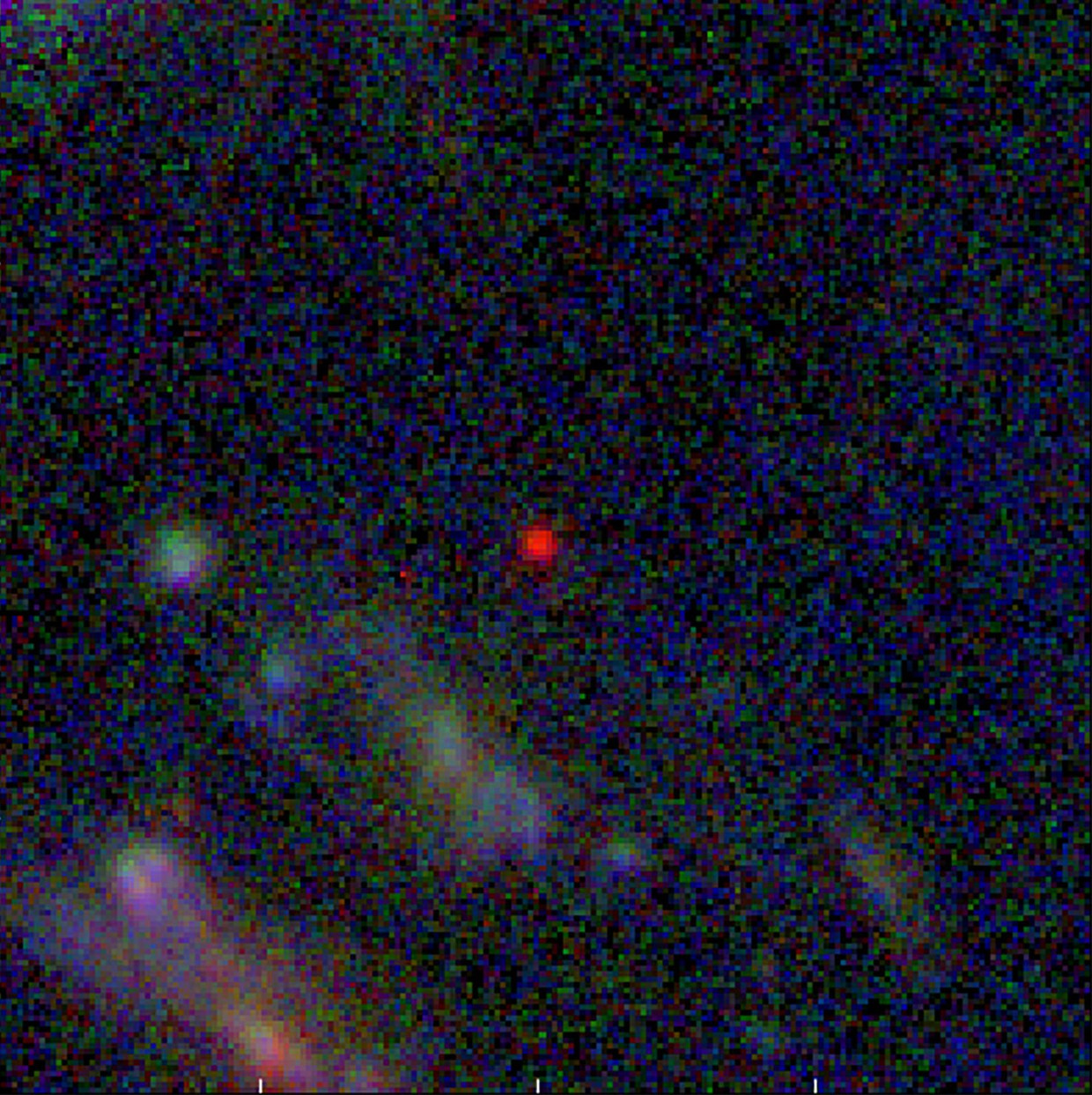There have already been charming images, but the first scientific results from the new James Webb Space Telescope are perhaps even more exciting. “We were expecting some surprises, but not so quickly or so radically.”
Is this the brake light for the car? Maybe the burning cigarette tip? Or an extremely enlarged image of the TV’s standby button? Match the dull red blocks to the angular pixels next to the amazing pictures From the James Webb Space Telescope published in mid-JulyImages filled with gracefully spread nebulae and sharp galaxies, soon shrugging your shoulders.
However, it is precisely those misty patches that are now causing increasing excitement among astronomers around the world, much more than the captivating cosmic vistas previously featured in the news.
If the first signs don’t deceive, these clusters of red pixels reveal the most distant galaxies humanity has ever seen. The galaxies you see here – very recent variants of the Milky Way in which we spend our cosmic lives – were captured by the camera as they appeared only a few hundred million years after the Big Bang. And while that sounds long by human standards, that time pales in comparison to the roughly 14 billion years the universe has existed. In short, the systems in the picture are very small. Some of them may be among the first galaxies to appear in the universe.
These cosmic baby pictures let you immerse yourself wonderfully in the enchanting depth of space, and amazingly long periods that dull human life. However, these galaxies are not just dreamy discoveries or amusing additions to astronomical record books. No, they are also of great scientific interest.
Indeed, such tiny galaxies can reveal the evolution of these cosmic bodies. Compare it to biologists who have so far only seen adult specimens of an animal species and then suddenly discovered the phylogenetic stage. Whether life began in an egg, as a tiny, floundering version of an adult animal, or whether you saw a caterpillar before it evolved into a butterfly: it makes a difference.
It’s the same thing in the universe. And if the initial discoveries were not deceptive, there have already been several indications that astronomers will soon have to adjust the prevailing view of the evolution of those galaxies, from the moment of the Big Bang to the present.
“It’s really incredible what the international community has actually found in the first two weeks since this data became public,” says astronomer Mariska Crick of Leiden University. “We already knew James Webb was going to reveal groundbreaking stuff. But now we’re seeing it for real. And she certainly doesn’t disappoint.”

Easy to get
The James Webb Space Telescope, the new pioneer of international astronomy, is the “successor” of the Hubble Space Telescope and has been built, among other things, to delve deeper into the universe than ever before. That is why it does not look at “ordinary” light, but at thermal radiation invisible to the human eye. The light from the depths of space extends all the way. What has long been visible – with a shorter wavelength – arrives here as thermal radiation, has a longer wavelength.
To extract this heat radiation from the cosmic depths, the bottom of the telescope is covered with a sun shield, the size of a tennis court, which keeps it cool. Partly because of this, Webb is so sensitive that if he were on Earth, he could measure the heat radiation from a bee on the moon.

It was obvious that this astronomical power would lead to amazing discoveries. However, astronomers around the world have been going from one surprise to the next since the telescope began collecting its data. “I don’t think any of us could have expected that we would see so many galaxies at such a great distance. We expected some surprises, but not so fast or drastically,” said astronomer Guido Roberts Borsani of the University of California last week. In front of the weekly popular science magazine new world.
Kriek sums up the first weeks: “We’re already picking the drooping fruits.” And although there are much more fruits, and above all much more beautiful than astronomers dared hope, now it is mainly a matter of hard work: analyzing as much measurement data as possible, accurately recording everything and describing it in specialized articles .
It is not yet time to separate the wheat from the wheat. “That’s why we have to be very careful,” warns astronomer Karina Capote of the University of Groningen, an expert on very distant galaxies. All results that appeared within the first two weeks have only been published on the scientific publishing site Arxiv. Only when other astronomers study these articles critically and rate them as satisfactory – so-called peer review – do they end up in mainstream journals. Even then, Capote says, we haven’t gotten that far yet. “The distance for all of these galaxies remains to be confirmed.”
redshift
Experts like Caputi determine the distance of distant galaxies using what’s known as redshift, a technical term referring to the fact that distant galaxies appear redder than nearby galaxies.
This is correct. Due to the expansion of the universe, galaxies farther away from us are moving away faster. The light moving away from you changes color like the siren of a speeding ambulance. And what is the tone of the sound, the color to the light: that is why the faster motion and therefore the far galaxies appear redder than the closer galaxies.
In their first approximate distance determination, astronomers simply look at how redder the galaxies are. Only: sometimes you accidentally get the wrong conclusion. “A galaxy surrounded by a lot of dust can sometimes appear redder than it should be based on its distance,” Capote says.

It would require you to look again at the very distant galaxies that exist now, in a slightly different, more subtle way, for confirmation. If, for example, it is possible to make a spectrum for such a system – a signature of the colors present in the light of such a system – you can determine the redshift very precisely, and you know the distance for sure.
“So I think for the second observational round, which is likely to start at the beginning of 2023, we will be getting a lot of requests to take verification measurements on very remote systems,” says Crick, who was active on one of the panels at this time of observation on James Webb. “For this first series of measurements, we had about four times the number of orders from the available observation time. I think the competition is going to get bigger from now on.”
frankly amazing
The discoveries of the first distant galaxies are not only surprising in number, the distances themselves in some cases are simply amazing. If the most distant galaxy seen by Hubble has a redshift of 11, which translates to an age of about 400 million years after the Big Bang, then James Webb’s data already identified a dozen candidates much later.
For example, on July 19, GLASS-z13 red spot on, with an estimated redshift of 13. This would immediately sharpen the record – if the discovery continues – by about 100 million years. Amazing, were it not for the fact that James Webb has been breaking his own records over and over lately.

Just look at the burning ash point of ‘Maisie’s Galaxy’, named after the explorer’s daughter, at a redshift of 14. Or no, stop: There are two systems again with a redshift of 16. One research group even suddenly stumbled upon systems last week at a redshift of 20approximately 180 million years after the Big Bang. It is the initial record.
Caputi predicts that it will be much more difficult to break this record. “The first galaxies formed during that time period,” she says. However, more and more galaxies in the sky are also less bright. “And then it becomes more and more difficult to see them.”
The question remains whether what we see now is real or a case of red illusion. Astronomer Rohan Naidoo of the Harvard-Smithsonian Center for Astrophysics said about it new world. So it must be very difficult if the current results are not left in the future.
Furthermore, Capote says, “The images in which these galaxies have been found are far from the deepest that James Webb would make of the universe. When I think about what we might have seen in six months… My God. ”

More massive, more regular, weirder
The first results of the James Webb Space Telescope shed light not only on very distant galaxies. suggest it New study Some galaxies are collecting more stars and masses faster than expected. “If that’s true, we really should go back to the drawing board,” says astronomer Mariska Crick. Fellow Karina Capote, however, doesn’t believe much of it. “They are using a new analytical method that has not yet been adequately tested,” she says.
Here is the problem with such studies: they are written down quickly and peer critical examination is still missing. However, they do show the kind of insights Webb can provide. This is how you discover one group More Tablet Systems From before, and the other Galaxies are more compact From what his predecessor Hubble saw, and a third reveals a strange, atypical galaxy Almost no heavy items it contains. It is the top of an ever-growing mountain of publications that can tilt the picture of the evolution of galaxies. Hence atmospheric measurements of distant planets, for example, have to begin with most of them.
“It’s like being in a theater and yet you can only see the universe through the cracks in the curtain,” says Crick. “With Webb, I opened those curtains. Now we suddenly see the whole stage.”

“Creator. Award-winning problem solver. Music evangelist. Incurable introvert.”







More Stories
Elections in the world's largest democracy: Can Indian Prime Minister Narendra Modi begin his third term?
The Spanish Meteorological Service warned of the danger of forest fires in several areas
Exclusion of the “Animals and Transparency” organization from the elections: “Shame”